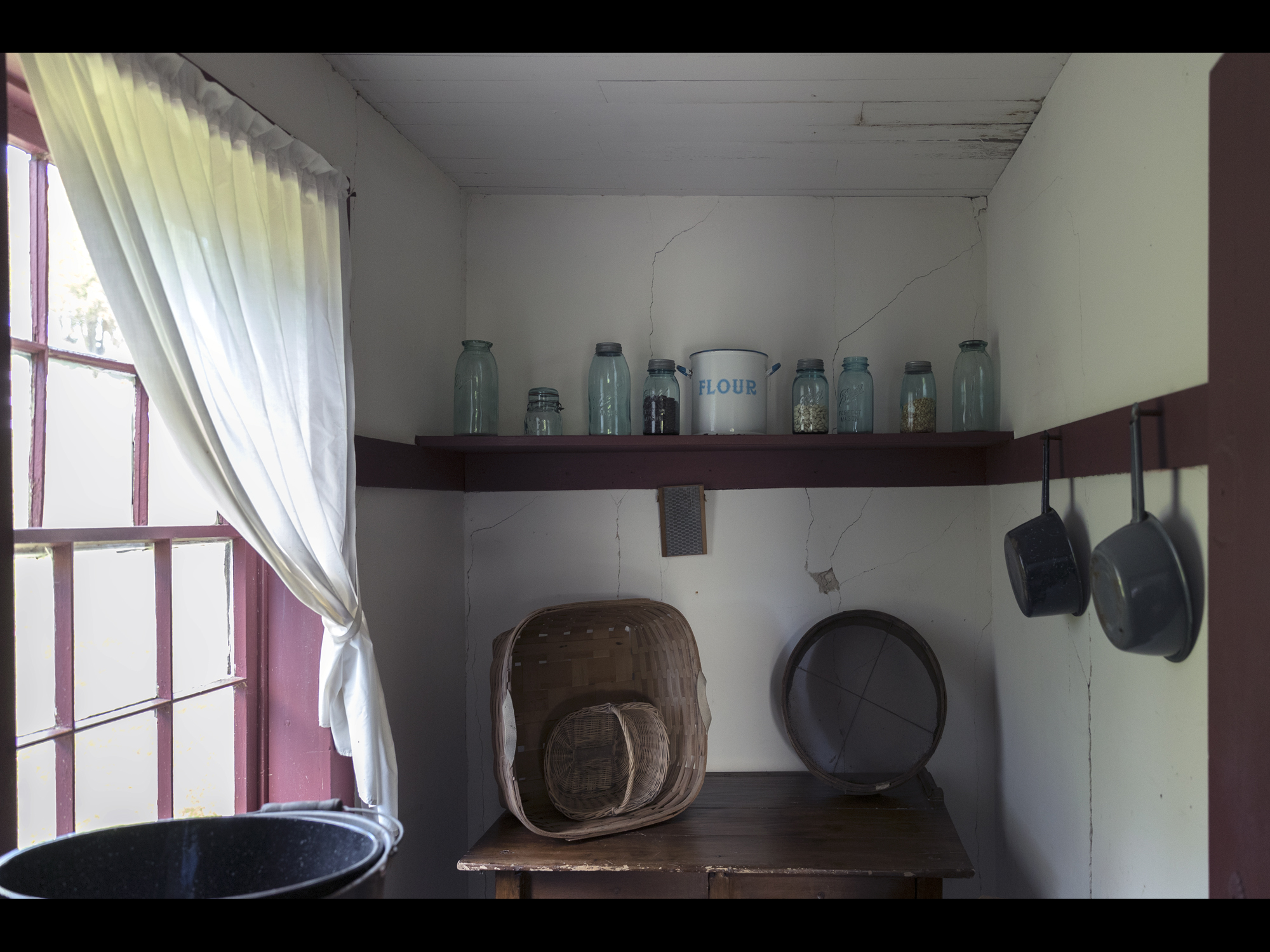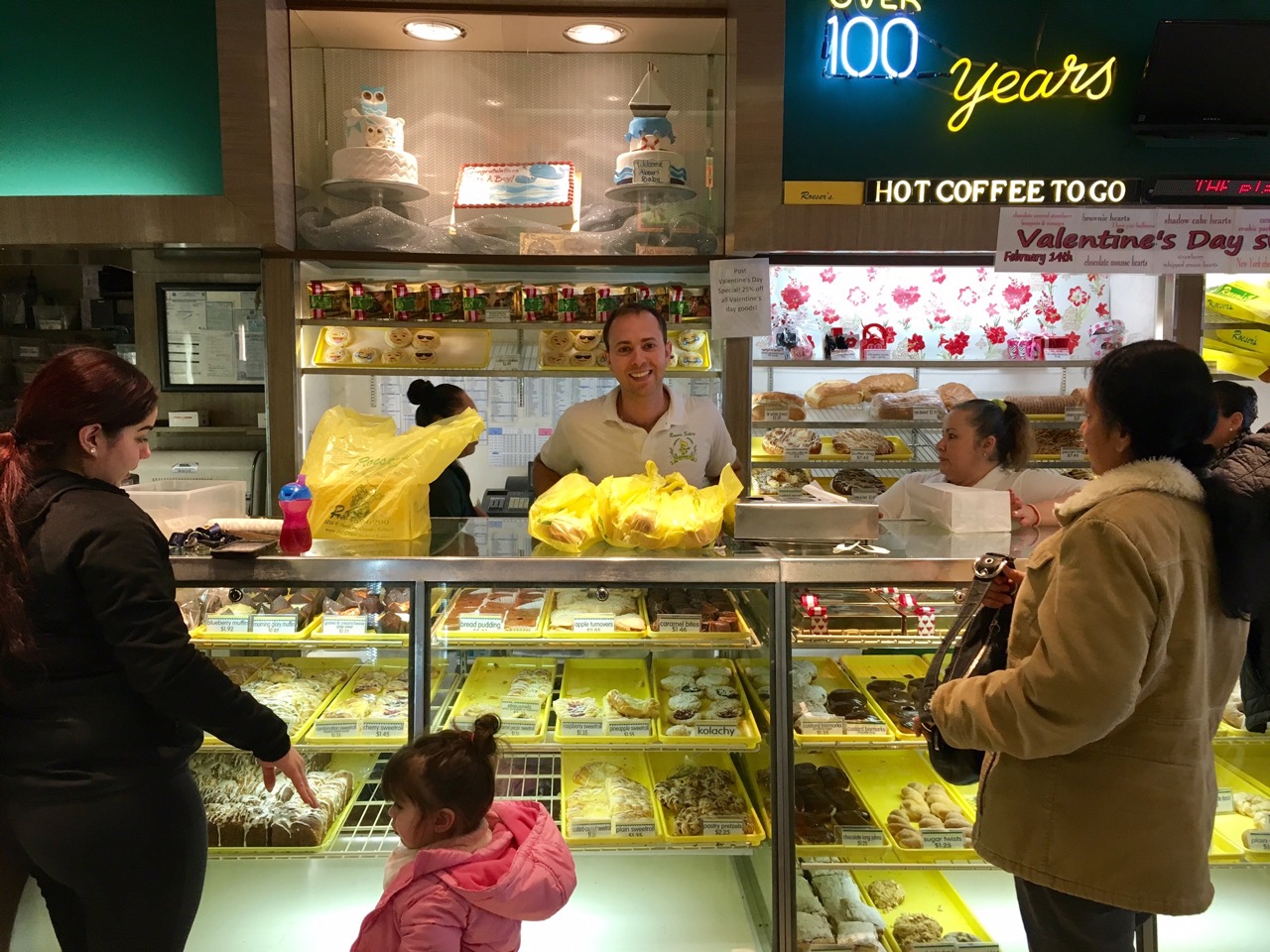THERE IS A FINE LINE SEPARATING FILIPINO desserts from snacks. We Filipinos don’t feel the need to restrict consumption of bready, cakey, sticky-sweet things to certain hours. This sentence, from a Filipino cookbook I bought on Amazon called, uh, “The Filipino Cookbook,” sums it up nicely: “For a Filipino, the best time to have a dessert is anytime—between meals, during meals, and after meals.”
Fair warning: If you’re going to explore the sweet side of Filipino food, you are in for a glycemic index-shattering experience.
Sticky rice, rice flour, coconut milk, ube, cassava, pandan, mocha, mango, cashew and… sponge cake. These are the prevailing themes in Filipino desserts, though if you spend any time on Instagram or have read the stories about how Filipino food is The Next Big Thing, you might think it’s all ube, all the time.
Let me be clear: Filipinos LOVE ube, a purple yam that tastes earthy and kind of sweet. Ube is in a lot of desserts. (For my money, ube ice cream is the way to go.) But pandan, the leaf used to flavor foods and tint them the color of AstroTurf, has a far more intriguing flavor, so much so I can’t find the words to describe it. Fragrant—that’s the best I can do.
And then there is this whole category of rice-based desserts/snacks, which seem on the surface to be all the same until you start eating them and dissecting their differences, which of course I did by phone with my mom when writing this.
With this in mind, I set out on a Filipino bakery tour of Chicago, to find reasonable facsimiles of the sweets I ate growing up and ones I’d somehow never tried.
Valerio’s Tropical Bakeshop
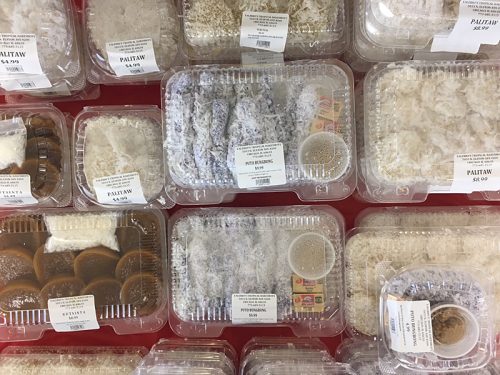
There is no shortage of sticky rice cakes at Valerio’s Tropical Bakeshop.
Where: 5033 N. Elston
Valerio’s is one of two California-based bakery chains operating independently inside the Filipino supermarket Seafood City, and the one worth your money. The other, Red Ribbon, is more well-known but disappointing, with individually packaged, commissary-baked pastries that look like the snack cakes I used to buy from the vending machine in high school.
There’s a heady and very real scent of warm dough and sugar at Valerio’s. Really, you could come here and not need to go anywhere else because pretty much every Filipino baked good, sweet and savory, is represented in volume and the shelves are constantly refreshed with stuff straight from the kitchen.
Here’s some of what Valerio’s sells: pandesal, a slightly sweet soft roll, and the related pan de coco, pan de leche and pan de ube; ensaymada, brioche-like rolls typically coated with butter and sugar or grated cheese; meat empanadas; ube cupcakes; ube-swirled sandwich bread, and your basic, everyday, cream-filled chiffon cake rolls.
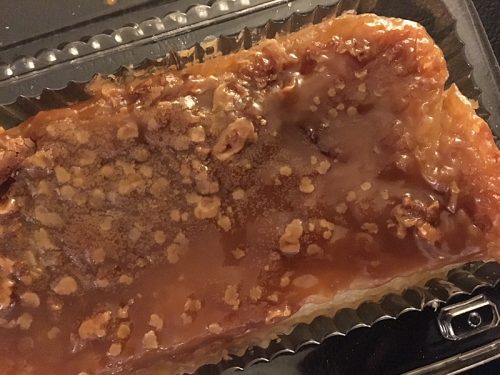
One of the best parts about bibingka malagkit is the syrupy top.
I had a Pavlovian response to the sticky rice cake section. Bibingka malagkit, a greatest hit from my childhood, is glutinous rice cooked, then baked, with coconut milk and sugar. It’s brown sugary and sticky, with a top of caramelized condensed milk. On the other hand, pichi-pichi, chewy, coconut-coated disks made of steamed grated cassava, sugar and water, are just sweet enough.
Don’t miss the tray of turon, 89 cents each, near the cash register. Ripe bananas (a Filipino variety, not the usual Cavendish) are wrapped in egg roll wrappers, deep-fried and lightly glazed. They shatter just so with each bite. Kudos to the fry cook, who doesn’t mess around.
Mariegold Bakery and Fast Food
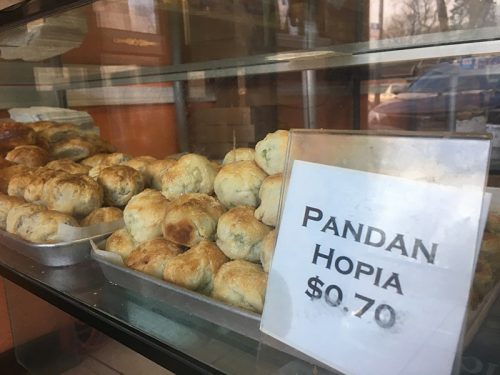
Hopia fill the bakery cases at Mariegold Bakery.
Where: 5752 N. California
Mariegold, a small bakery/grocery/turo-turo restaurant, also sells freshly fried turon by its cash register, but they’re stubbier and tougher than Valerio’s.
No, the best thing here is the first thing you see in the front case when you walk in: piles of perfectly flaky hopia, small, round pastries filled with a paste of sweetened mongo (mung bean), pandan or ube. At 70 cents a piece, it’s too easy to buy them by the bagful.
A small refrigerated case against the opposite wall holds more desserts, including leche flan, cassava cake and, the day I was there, a whole buko pie, that is, a custard pie packed with young coconut (buko). An employee told me it’s a special-order item. I couldn’t commit to the whole thing—I now regret this—and they wouldn’t sell me just a slice, but knowing I can order one is comforting.
Mom’s Bake Shoppe and Restaurant
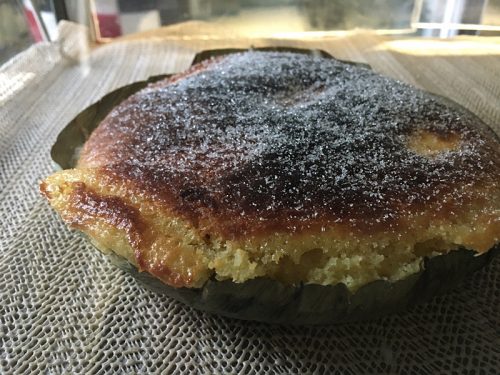
Bibingka galapong at Mom’s Bake Shoppe is as authentic as it gets.
Where: 2415 W. Peterson
The bibingka malagkit at Valerio’s is one type of bibingka, different from the version I ate a lot of growing up, which I always think of as the standard, made not with glutinous rice but rice flour. It’s cakey but not in a moist birthday-cake way. Depending on the cook, it might have cheese on top or sliced, hard-boiled egg baked inside.
At Mom’s, which is a bakery and restaurant, I learned that this version has a name: bibingka galapong. And here, it’s the real deal, made not with rice flour but with ground rice. It’s baked in banana leaf in an oven from the Philippines meant for baking bibingka, in that the heat fires on the top and bottom, according to the sister of the owner. It’s a beauty, Mom’s bibingka.
The espasol is also textbook. If you like mochi, you’ll like these smooth, chewy rounds made of toasted sweet rice flour and coconut milk. They’re flecked with strips of tender coconut and dusted in more rice flour, which adds more of that toasty flavor I find irresistible.
Beyond rice cakes, sweet breads and pastries, there’s a whole case of special-occasion cakes and frosted cake rolls, but alas, none by the slice.
Rowie’s Bakery
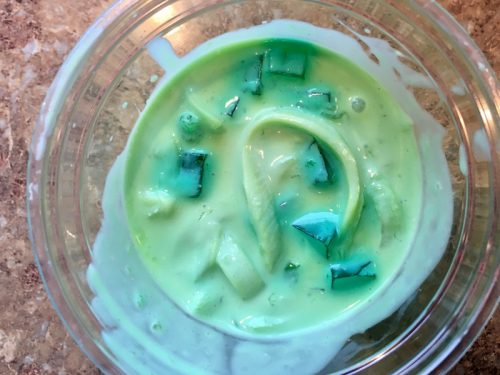
The buko pandan dessert cup at Rowie’s is hard to miss and even harder to describe.
Where: 5664 N. Lincoln
Mom’s and Mariegold are old school. Rowie’s is not. It’s the closest thing to the new-wave Filipino bakeries in Los Angeles that my best friend there keeps telling me about, the ones turning out ube Long Johns and ensaymada-kouign amann mashups. Rowie’s doesn’t make those, not yet anyway, but it does macarons, cupcakes and cookies in eye-catching flavors, from red velvet to, yes, ube and pandan, as well as custom cakes and more traditional sweets.
If you want to go full-on pandan, try the buko pandan. It’s pandan cream mixed with green jelly cubes, tapioca pearls and generous strips of young coconut, and it’s all very green and creamy and not like any flavor you’ve had. It’s a skimpy cupful for $2.25 but then, these aren’t cheap ingredients.
Rowie’s also does a tasty little cassava cake, sold in individual foil pans. Texturewise, it’s somewhere between chewy bibingka and firm rice pudding. I like to think all that cassava and coconut milk make it nutritious. Whatever. It tastes like home.
Simple Delights

A simple, and damn fine, sponge cake at Simple Delights.
Where: 6255 N. McCormick
This bakery, which also is a steam-table lunch place, focuses almost exclusively on breads. Apparently, they supply pandesal to other grocery stores, so there’s plenty of just-baked rolls, plus ensaymada, hopia, empanadas and mamon. It’s a lot of beige.
Mamon is a simple sponge cake, but I also consider it a barometer of quality like a baguette at a French bakery or roast chicken at any restaurant that dares put it on the menu. The best mamon is light and fluffy, not so dense-crumbed that it sticks in the back of your throat. So here’s the deal with the mamon at Simple Delights: This place is not close to my house, but I would make the 20-minute (in good traffic) drive just for these damn 4-inch sponge cakes.
Jennivee’s Bakery
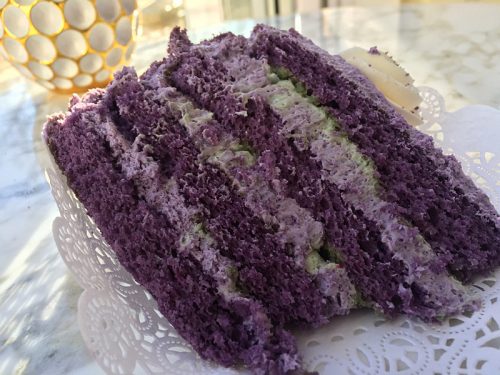
The ube cake trend is alive and well at Jennivee’s Bakery.
Where: 3301 N. Sheffield
I wouldn’t call this a Filipino bakery. It’s a charming spot with Southern-style layer cakes, buttercream-piped cupcakes and big cookies that kids go nuts for. But the owner is Filipino, which explains the towering ube and mango layer cakes in the display case. If you can’t resist the pull of the ube bandwagon, hop on here.
It’s dubbed the Purple Velvet cake: four moist ube cake layers with an ube mousse and coconut filling. Six dollars a slice, but it’s a Gibsons-level slice. Will you be blown away by the flavor of ube? I mean, does red velvet taste like much of anything? Still, it’s delicious and you will probably end up Instagramming it.
Janet Rausa Fuller is a former Sun-Times scribe and a current consumer of yeast-raised sweet things.
Cover image: pandan, ube and mung bean filled hopia, from Mariegold Bakery.
Latest
Join the Discussion
After you comment, click Post. If you're not already logged in you will be asked to log in or register with Disqus.





